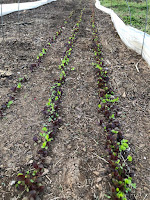Let's remain hopefully and think about the wonderful things we have to look forward to. Spring is an exciting time for gardeners and homesteaders. For us, it means longer days and more daylight. We don't have to keep the wood stove burning as much, so we don't have to keep up with firewood and cleaning out the ashes. That makes my daughter really happy.
 |
| Salad mix with row covers for protection on cold nights |
The crops we overwintered in our greenhouse are starting to take off and we are thrilled to have warmer days. This time of year can bring on some challenges also. Raccoons, foxes, hawks and coyotes are now prowling around, which means our chickens have to be extra careful. We do everything we can to protect them but if they fly over the electric fencing, they become vulnerable, and believe me, a fox will outsmart chicken even on a bad day.
We are starting radishes, salad mix, salad turnips, beets, pac choy, brussel sprouts and other leafy greens. These cool season crops thrive in the warm days and cool nights.
We have started our first peppers and tomatoes in our greenhouse but it will be a couple weeks before we set those out. I'm tempted to set out a few early plants but I know what will happen if I do too early. Frost will get them. Our last frost date here in Middle TN is May 1. We patiently wait for May 1, then we have to juggle rain showers. Is the ground too wet, is it too dry to plant? When we catch the weather right we jump all over the opportunity to plant our food.
 |
| Pac choy planted with compost spread around |
The garden is an extraordinary place on the homestead, it represents life, hope and challenges that await. It's a place where we can make money by harvesting and selling niche crops. Its also a place where failure is always lurking and one wrong move could mean death to the crop for that year. That's heartbreaking, because sometimes you only have one chance to get it right, otherwise you have to wait for next year. A lot of life lessons can be learned in the garden. If you have too many weeds in your garden, your plants will suffer and eventually succumb to pressure. Isn't that true with life?
This time of year is very inspiring and you don't have to look far for encouragement. Just take time and observe nature, walk outside and listen for birds. Take a moment and just watch them, don't think about anything else except nature. Spring is right around the corner!
Jason Smith
Homesteader and Market Gardener
Email: jason@smithfamilyfarmtn.com
YouTube Channel: https://www.youtube.com/channel/UCH_6SzCMTTkjND
S8qU2TzEg
Website: www.smithfamilyfarmtn.com










